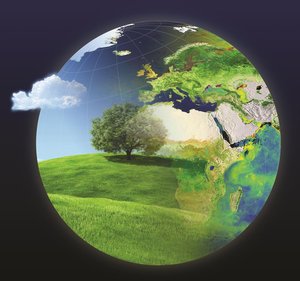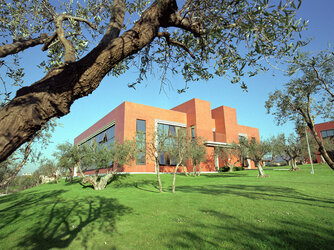New dimensions to monitor Earth prove ever-more useful
With interest growing in satellite radar techniques that provide 3D views of Earth's natural and urban environments, scientists from around the world recently gathered to review the latest findings and show how these methods can be used to monitor our changing world.
The technique of Synthetic Aperture Radar (SAR) radar polarimetry allows polarised information to be measured in the signals backscattered from Earth to a satellite sensor. Polarimetric interferometry is achieved by using two polarimetric images, acquired from slightly different angles, to provide information on the 3D structure of the view.
With the opportunity to review the advances made in this field, more than 200 researchers from over 24 countries came together at the biennial POLinSAR workshop held at ESA's centre for Earth observation in Italy.
In response to growing interest in this field, ESA also hosted a week-long course just prior to the event so that PhD students could learn more about the theory and practical ways of using these data for new applications.

Currently, data come largely from Canada's Radarsat-2 and Japan's ALOS mission. However, Germany's newly launched
TanDEM-X promises to play an important role in the future of SAR polarimetry.
Results demonstrate how the techniques are becoming more useful, in particular for assessing water resources and carbon stocks.
For example, a year's worth of data from Radarsat-2 has been used to create a time-series of images of an area of wetland in northern France.

Prof. Eric Pottier from the University of Rennes 1 explained, "Collaboration between ESA and the Canadian Space Agency within the Science and Operational Applications Research for Europe project has yielded, for the first time, time-series of data to closely monitor wetlands.
"Wetlands are extremely dynamic ecosystems. Not only are they an important haven for wildlife, but are also sources of atmospheric methane.
"These new time-series have demonstrated that we can monitor the water levels in the area, which helps to improve management practices.
"Moreover, the data can also be incorporated into models to help predict emissions of methane to the atmosphere."

Another exciting result has been the discovery of historical forest fire scars. Dr Shane Cloude from AEL Consultants said, "Using data from ALOS for test sites in remote northern Canada, we have been able to detect scars from fires set 10 to 20 years ago, thus allowing a time sequencing technique.
"Even through new tree growth we can easily detect these old scars, which help us work out how often fires occur and, thus, how much carbon is being put into the atmosphere, which is important for climate change."
Polarimetric interferometic data may also be used to map urban environments in 3D, as the animation at the top shows.
This 3D reconstruction of Toulouse, France, was derived from SAR data collected by the airborne system RAMSES from ONERA, the French Aerospace Lab.

Looking to the future, results from some of ESA's airborne campaigns to support the development of the candidate Earth Explorer BIOMASS mission were presented.
These results show how the mission could, if selected as the seventh Earth Explorer, detect and map changes in forest biomass over time.
It was also demonstrated that, through tomography data acquisition and processing, a full 3D image of some forests could be achieved.















 Germany
Germany
 Austria
Austria
 Belgium
Belgium
 Denmark
Denmark
 Spain
Spain
 Estonia
Estonia
 Finland
Finland
 France
France
 Greece
Greece
 Hungary
Hungary
 Ireland
Ireland
 Italy
Italy
 Luxembourg
Luxembourg
 Norway
Norway
 The Netherlands
The Netherlands
 Poland
Poland
 Portugal
Portugal
 Czechia
Czechia
 Romania
Romania
 United Kingdom
United Kingdom
 Slovenia
Slovenia
 Sweden
Sweden
 Switzerland
Switzerland





























